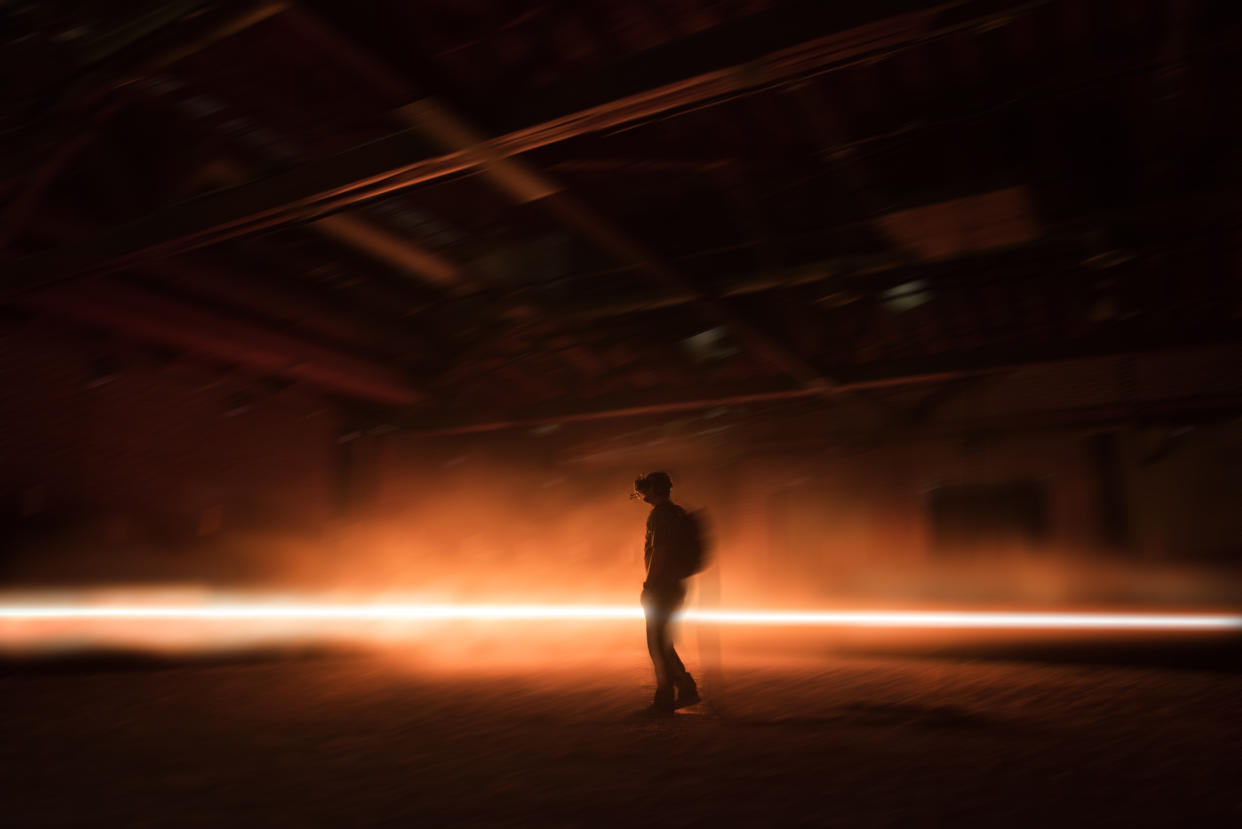Alejandro G. Iñárritu Strikes At Heart Of Immigrant Experience With Virtual Reality Installation “CARNE y ARENA” – Cannes

There has been much written about the potential of virtual reality as a new medium for artists, but Alejandro G. Iñárritu’s CARNE y ARENA, the first VR project selected for the Cannes Film Festival, might be as definitive for this art form as the Lumières’ L’Arrivée d’un train en gare de La Ciotat was for film; the first meaningful step towards establishing the true possibility of the form. It opened this morning and will run for 10 days in Cannes before traveling to the Prada Foundation in Milan in June. Deadline was the first inside, and with only three participants per half-hour time slot, fewer than 100 people will experience CARNE y ARENA each day in Cannes.
The journey begins with a trip in one of the festival’s leather-lined sedans from the Gare Maritime. Perhaps less to punctuate the social distinction between this and a real immigrant journey than for practical reasons: Mandelieu is the Cannes-adjacent town with a hangar large enough to house the installation and it takes 20 minutes to get there. Another privilege-checking irony: this first setup for the installation is taking place at Cannes-Mandelieu airport where the best-heeled of the A-list will arrive for the festival on private jets.
The exhibition itself is starting from the moment I step into “the freezer”, designed to mimic border control holding cells, where my shoes and socks are removed and the guttural whirr of some unseen machine rattles the walls. After a while, an alarm sounds, and I step into a dark room with sand on the floor, where a technician and two spotters wait to fit me with a VR headset, a set of headphones and a backpack. There are few limits on my movement. The space is cavernous and small rocks on the room’s edge stop me from bumping into its walls—though I only once risked doing so.
These technical details are nothing for the emotional experience of the six-and-a-half minutes Iñárritu and cinematographer Emmanuel Lubezki situate me in the middle of the desert as a group of migrants attempts a border crossing. There are men, women, and children, navigating in the almost pitch black, in search of a better life. Each of them is a real person, whose story has been collected for the installation. I watch an old woman collapse on the ground on feet that will no longer carry her. A man puts in a call to signal that the group has arrived at a meeting point.
And then, a rumble in the distance. The wind picks up and a helicopter rushes overhead. Border guards arrive in cars with blinding headlights, and I come face to face with a high-powered assault rifle. I’m ordered to get on my knees and I feel compelled to comply, raising my arms in the air. There is no real threat here, but in the moment I am convinced there is.
I hear more stories as the border guards round up and arrest the group. One speaks good English; he’s an attorney he tells the officers. A small boy looks up at the men with guns. “How old are you?” one asks him. He stays silent. He can be no more than 10. A woman passes a bottle of baby milk to a man sat on the ground. It’s only then that I spot a tiny infant clutched to his chest, frightened by the commotion.
It’s when a border control guard rushes straight through me that I find the surprise of CARNE y ARENA—one that many might miss because the verisimilitude of the experience has me convinced that I am surrounded by these struggling people. Inside the officer’s chest, I come face to face with his beating heart. It feels intrusive to do so, but I peer into the immigrants themselves. The same beating heart in each one. This is the core of Iñárritu’s message: though we trifle with human constructs about difference, border lines, and division, we are all the same, Legendary’s Mary Parent tells me afterward.
As the experience ends, I step into a small dark room to be reunited with my shoes. From there, I’m led down a corridor full of video portraits of the immigrants and a border guard who tell their own stories about these perilous crossings. I’m grateful to be alone, and I find an added empathy with these people that other art forms would have struggled to impart. There is nothing gimmicky about the emotional experience CARNE y ARENA offers. It’s confronting and heartbreaking—and it challenges the faulty logic of anti-immigrant rhetoric.
Though no more than 1000 people will see CARNE y ARENA over its run in Cannes, after its time in Milan the installation, produced by Legendary Entertainment and Fondazione Prada, will transfer to The Los Angeles County Museum of Art in July and the Tlatelolco Museum in Mexico City. Parent says she has been besieged by offers from all over the world to host it, so further bookings are likely. This is not film, and not a video game, but rather something entirely unique. Where earlier experimentation with VR has steered it toward the rules and language of other forms, here Iñárritu and Lubezki have broken ground on legitimizing VR as its own medium, and they promise an exciting future.
Related stories
Legendary Entertainment CFO & General Counsel Both Out As Mary Parent Builds Own Team
Johnny Depp To Be 'King Of The Jungle'; IMR To Handle Foreign Sales At Cannes
Get more from Deadline.com: Follow us on Twitter, Facebook, Newsletter

 Yahoo Movies
Yahoo Movies 
